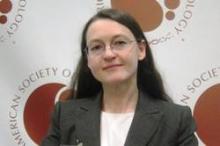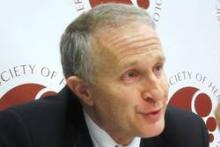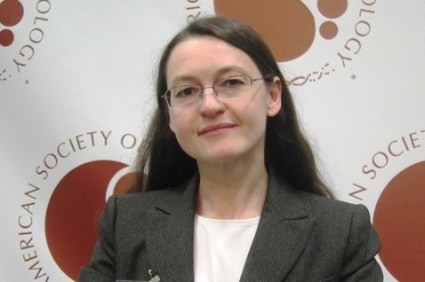User login
NEW ORLEANS – Older patients with hematologic malignancies should be offered reduced-intensity haploidentical bone marrow transplants if followed with high-dose cyclophosphamide, a study indicates.
Overall outcomes and toxicities were not only comparable between patients in their 50s, 60s and 70s, but similar to those seen with matched bone marrow transplantation (BMT), Dr. Yvette Kasamon reported at the annual meeting of the American Society of Hematology.
"Since many elderly patients may lack a suitable matched sibling donor, the haplo option becomes even more attractive," Dr. Kasamon, with the Sidney Kimmel Comprehensive Cancer Center at Johns Hopkins Hospital, Baltimore, said during a press briefing.
The current results are likely to spark a dramatic expansion in related haploidentical -- or half-matched -- transplants, which are performed at relatively few transplant centers because of concerns of excessive risk.
"What this adds is another option that is safe in the elderly — and that’s a lot of people," commented Dr. Jeffrey S. Miller, with the University of Minnesota Blood and Marrow Transplant Clinic in Minneapolis. "The incidence of AML goes up with age. So you’re talking about a population, at least with acute myeloid leukemia, where the elderly are the target population for the disease and typically those patients would not get transplants. Now we’re hearing that this is actually the treatment of choice and the outcomes are better."
Recent advances such as cord blood transplants and reduced-intensity conditioning BMT have increased transplants, but another major advance was the introduction of high-dose, post-transplant cyclophosphamide for graft-versus-host disease prophylaxis, Dr. Kasamon said. With post-transplant cyclophosphamide, reduced-intensity haplo BMT has been shown to be safe and effective (Blood 2011;118:282-8).
To examine the impact of older age on this approach, Dr. Kasamon and her colleagues retrospectively analyzed 273 consecutive patients, aged 50-75 years, treated at Johns Hopkins for poor-risk lymphoma (n=153), acute leukemia or myelodysplastic syndrome (n=96), and other hematologic malignancies (n=24). The preconditioning regimen was comprised of cyclophosphamide, fludarabine, and 200 cGy of total body irradiation, with two doses of cyclophosphamide post-transplant. No prior allogeneic* BMT was allowed and post-BMT rituximab (Rituxan) was used in 55 of 126 patients with B-cell lymphoma.
Patients in their 50s, 60s, and 70s had similar estimated 2-year progression-free survival (39%, 36%,and 39%, respectively) and overall survival (51%, 56%, and 44%, respectively).
The risk of non-relapse death was similar at 6 months (11% overall) and the risk was only 3% for severe acute graft-versus-host disease, which makes these risks comparable to what is seen in patients with matched transplants, Dr. Kasamon said.
"With recent advances in how we do these transplants, haploidentical transplants are a very reasonable consideration for patients who don’t have matched donors and who are otherwise in desperate need of transplant," she said.
The procedure will also reduce the time spent hunting for an unrelated match, which is a 50-50 chance for some and even worse odds for African-Americans, who have a limited chance of an unrelated match. Almost every patient has at least one haploidentical relative, often sitting alongside their bed, Dr. Kasamon said.
Based on the data, Johns Hopkins recently lifted its upper age limit of 75 years for transplants, and now looks to performance status and overall functioning to determine a patient’s fitness for transplant. "As long as they can meet our criteria, age is no longer a barrier at our institution," she noted.
Dr. Kasamon and her co-authors reported having no financial disclosures.
pwendling@frontlinemedcom.com
*Correction, 12/16/2013: An earlier version of this story did not specify that patients with prior allogenic bone marrow transplants were excluded from the study. Details related to the risk of non-relapse death also were misstated.
NEW ORLEANS – Older patients with hematologic malignancies should be offered reduced-intensity haploidentical bone marrow transplants if followed with high-dose cyclophosphamide, a study indicates.
Overall outcomes and toxicities were not only comparable between patients in their 50s, 60s and 70s, but similar to those seen with matched bone marrow transplantation (BMT), Dr. Yvette Kasamon reported at the annual meeting of the American Society of Hematology.
"Since many elderly patients may lack a suitable matched sibling donor, the haplo option becomes even more attractive," Dr. Kasamon, with the Sidney Kimmel Comprehensive Cancer Center at Johns Hopkins Hospital, Baltimore, said during a press briefing.
The current results are likely to spark a dramatic expansion in related haploidentical -- or half-matched -- transplants, which are performed at relatively few transplant centers because of concerns of excessive risk.
"What this adds is another option that is safe in the elderly — and that’s a lot of people," commented Dr. Jeffrey S. Miller, with the University of Minnesota Blood and Marrow Transplant Clinic in Minneapolis. "The incidence of AML goes up with age. So you’re talking about a population, at least with acute myeloid leukemia, where the elderly are the target population for the disease and typically those patients would not get transplants. Now we’re hearing that this is actually the treatment of choice and the outcomes are better."
Recent advances such as cord blood transplants and reduced-intensity conditioning BMT have increased transplants, but another major advance was the introduction of high-dose, post-transplant cyclophosphamide for graft-versus-host disease prophylaxis, Dr. Kasamon said. With post-transplant cyclophosphamide, reduced-intensity haplo BMT has been shown to be safe and effective (Blood 2011;118:282-8).
To examine the impact of older age on this approach, Dr. Kasamon and her colleagues retrospectively analyzed 273 consecutive patients, aged 50-75 years, treated at Johns Hopkins for poor-risk lymphoma (n=153), acute leukemia or myelodysplastic syndrome (n=96), and other hematologic malignancies (n=24). The preconditioning regimen was comprised of cyclophosphamide, fludarabine, and 200 cGy of total body irradiation, with two doses of cyclophosphamide post-transplant. No prior allogeneic* BMT was allowed and post-BMT rituximab (Rituxan) was used in 55 of 126 patients with B-cell lymphoma.
Patients in their 50s, 60s, and 70s had similar estimated 2-year progression-free survival (39%, 36%,and 39%, respectively) and overall survival (51%, 56%, and 44%, respectively).
The risk of non-relapse death was similar at 6 months (11% overall) and the risk was only 3% for severe acute graft-versus-host disease, which makes these risks comparable to what is seen in patients with matched transplants, Dr. Kasamon said.
"With recent advances in how we do these transplants, haploidentical transplants are a very reasonable consideration for patients who don’t have matched donors and who are otherwise in desperate need of transplant," she said.
The procedure will also reduce the time spent hunting for an unrelated match, which is a 50-50 chance for some and even worse odds for African-Americans, who have a limited chance of an unrelated match. Almost every patient has at least one haploidentical relative, often sitting alongside their bed, Dr. Kasamon said.
Based on the data, Johns Hopkins recently lifted its upper age limit of 75 years for transplants, and now looks to performance status and overall functioning to determine a patient’s fitness for transplant. "As long as they can meet our criteria, age is no longer a barrier at our institution," she noted.
Dr. Kasamon and her co-authors reported having no financial disclosures.
pwendling@frontlinemedcom.com
*Correction, 12/16/2013: An earlier version of this story did not specify that patients with prior allogenic bone marrow transplants were excluded from the study. Details related to the risk of non-relapse death also were misstated.
NEW ORLEANS – Older patients with hematologic malignancies should be offered reduced-intensity haploidentical bone marrow transplants if followed with high-dose cyclophosphamide, a study indicates.
Overall outcomes and toxicities were not only comparable between patients in their 50s, 60s and 70s, but similar to those seen with matched bone marrow transplantation (BMT), Dr. Yvette Kasamon reported at the annual meeting of the American Society of Hematology.
"Since many elderly patients may lack a suitable matched sibling donor, the haplo option becomes even more attractive," Dr. Kasamon, with the Sidney Kimmel Comprehensive Cancer Center at Johns Hopkins Hospital, Baltimore, said during a press briefing.
The current results are likely to spark a dramatic expansion in related haploidentical -- or half-matched -- transplants, which are performed at relatively few transplant centers because of concerns of excessive risk.
"What this adds is another option that is safe in the elderly — and that’s a lot of people," commented Dr. Jeffrey S. Miller, with the University of Minnesota Blood and Marrow Transplant Clinic in Minneapolis. "The incidence of AML goes up with age. So you’re talking about a population, at least with acute myeloid leukemia, where the elderly are the target population for the disease and typically those patients would not get transplants. Now we’re hearing that this is actually the treatment of choice and the outcomes are better."
Recent advances such as cord blood transplants and reduced-intensity conditioning BMT have increased transplants, but another major advance was the introduction of high-dose, post-transplant cyclophosphamide for graft-versus-host disease prophylaxis, Dr. Kasamon said. With post-transplant cyclophosphamide, reduced-intensity haplo BMT has been shown to be safe and effective (Blood 2011;118:282-8).
To examine the impact of older age on this approach, Dr. Kasamon and her colleagues retrospectively analyzed 273 consecutive patients, aged 50-75 years, treated at Johns Hopkins for poor-risk lymphoma (n=153), acute leukemia or myelodysplastic syndrome (n=96), and other hematologic malignancies (n=24). The preconditioning regimen was comprised of cyclophosphamide, fludarabine, and 200 cGy of total body irradiation, with two doses of cyclophosphamide post-transplant. No prior allogeneic* BMT was allowed and post-BMT rituximab (Rituxan) was used in 55 of 126 patients with B-cell lymphoma.
Patients in their 50s, 60s, and 70s had similar estimated 2-year progression-free survival (39%, 36%,and 39%, respectively) and overall survival (51%, 56%, and 44%, respectively).
The risk of non-relapse death was similar at 6 months (11% overall) and the risk was only 3% for severe acute graft-versus-host disease, which makes these risks comparable to what is seen in patients with matched transplants, Dr. Kasamon said.
"With recent advances in how we do these transplants, haploidentical transplants are a very reasonable consideration for patients who don’t have matched donors and who are otherwise in desperate need of transplant," she said.
The procedure will also reduce the time spent hunting for an unrelated match, which is a 50-50 chance for some and even worse odds for African-Americans, who have a limited chance of an unrelated match. Almost every patient has at least one haploidentical relative, often sitting alongside their bed, Dr. Kasamon said.
Based on the data, Johns Hopkins recently lifted its upper age limit of 75 years for transplants, and now looks to performance status and overall functioning to determine a patient’s fitness for transplant. "As long as they can meet our criteria, age is no longer a barrier at our institution," she noted.
Dr. Kasamon and her co-authors reported having no financial disclosures.
pwendling@frontlinemedcom.com
*Correction, 12/16/2013: An earlier version of this story did not specify that patients with prior allogenic bone marrow transplants were excluded from the study. Details related to the risk of non-relapse death also were misstated.
AT ASH 2013
Major finding: Patients in their 50s, 60s, and 70s had similar estimated 2-year progression-free survival (39%, 36%, 39%) and overall survival (51%, 56%, 44%).
Data source: A retrospective study of 273 consecutive patients with leukemia or lymphoma.
Disclosures: Dr. Kasamon and her co-authors reported having no financial disclosures.


